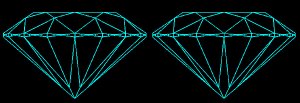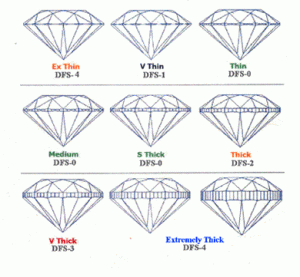BlingChaser
Rough_Rock
- Joined
- Nov 7, 2006
- Messages
- 21
Here is an interesting story which i thought i might share with the forum and was hoping to get some feedback possibly from dealers and appraisers:
On my most recent visit to my Brick and Mortar jeweller (had bought a 1.81 round E SI2 previously and was looking to buy a bangle) he started telling me how this time of the year is slow for engagement ring material but very busy for gold trinkets and the occasional big purchase. He just had 2 clients in for a 3.35 and 5.2 stones which were waiting to be set. Since he had nothing else to do he showed me and my wife the 2 stones.
Using a loupe and the trusty idealscope and ideal light (i never go there without these), these diamonds seemed to be beautifully i.e cut good light return and pronounced arrows .
He then proceeded to tell me how if i wanted he could cut me a good deal on 1ct stones since he has too many and wanted to buy bigger stones. He showed me 12 stones and all of them were 1.00 - 1.02 without showing me their respective certificates. Out of the 12 i only possibly like 2 as i tend to be very conservative since i do not have a lot of experience looking at stones.
The reason i discarded the other 10 stones was due to the fact that they either were deep ( thin arrows) or the girdle seemed thick in comparison with the 2 good ones.
Now since Rappaport breaks down price according to some carat range: [1.00ct - 1.49ct], [1.50 - 1.99], [2.00 - 2.99] (do not know what comes afterwards), it seemed to me that there is a higher chance of getting shown a bad cut (bigger depth and girdle) if you choose a stone with a carat towards the low end of the rap range. That is stones of carat 1.00, 1.01, 1.50, 1.51, 2.00, 2.01 have a higher chance of having bad cuts as the diamond cutter would have an incentive to push the stone in that rappaport range.
I was hoping dealers and appraisers could comment on the above statement and i was also wondering if the same applies to bigger stones say 3.01 and 5.01 carats.
By the way is there a good way o figuring out if girdle is thick or not?
On my most recent visit to my Brick and Mortar jeweller (had bought a 1.81 round E SI2 previously and was looking to buy a bangle) he started telling me how this time of the year is slow for engagement ring material but very busy for gold trinkets and the occasional big purchase. He just had 2 clients in for a 3.35 and 5.2 stones which were waiting to be set. Since he had nothing else to do he showed me and my wife the 2 stones.
Using a loupe and the trusty idealscope and ideal light (i never go there without these), these diamonds seemed to be beautifully i.e cut good light return and pronounced arrows .
He then proceeded to tell me how if i wanted he could cut me a good deal on 1ct stones since he has too many and wanted to buy bigger stones. He showed me 12 stones and all of them were 1.00 - 1.02 without showing me their respective certificates. Out of the 12 i only possibly like 2 as i tend to be very conservative since i do not have a lot of experience looking at stones.
The reason i discarded the other 10 stones was due to the fact that they either were deep ( thin arrows) or the girdle seemed thick in comparison with the 2 good ones.
Now since Rappaport breaks down price according to some carat range: [1.00ct - 1.49ct], [1.50 - 1.99], [2.00 - 2.99] (do not know what comes afterwards), it seemed to me that there is a higher chance of getting shown a bad cut (bigger depth and girdle) if you choose a stone with a carat towards the low end of the rap range. That is stones of carat 1.00, 1.01, 1.50, 1.51, 2.00, 2.01 have a higher chance of having bad cuts as the diamond cutter would have an incentive to push the stone in that rappaport range.
I was hoping dealers and appraisers could comment on the above statement and i was also wondering if the same applies to bigger stones say 3.01 and 5.01 carats.
By the way is there a good way o figuring out if girdle is thick or not?






300x240.png)